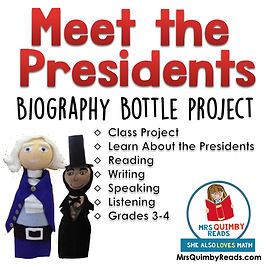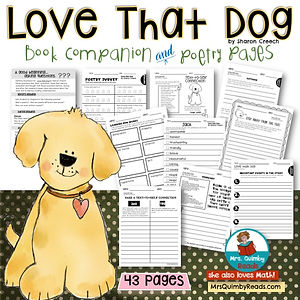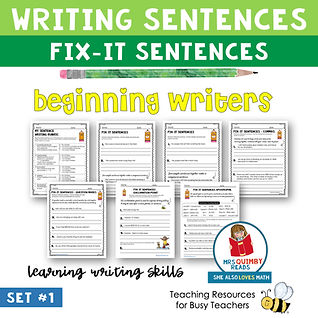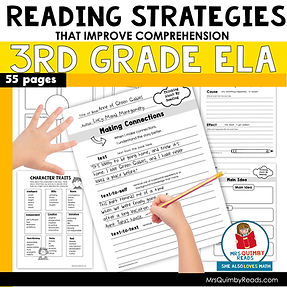
MrsQuimbyReads
helping teachers with lesson plans and
teaching resources that bring joy to learning!
third Grade

Those Shoes by Maribeth Boelts
Jeremy is a likeable and admirable character who learns a life lesson of wants and needs. Get this book companion to write about this book.
just click HERE
by Kate DiCamillo
Louisiana is a likeable and admirable character who learns the true identity of herself and her Grandma. Get this book companion to write about this book. just click HERE
by Katherine Applegate
Ivan is the one and only but does he really want to be? This book teaches kindness and belonging like no other. Ivan is the most likable gorilla I have ever read about... and he's real. Ivan draws pictures and he saves Ruby, the elephant.
Many insightful discussions will happen because of this touching story by Katherine Applegate. Get this book companion to write about this book. just click HERE
by George Selden
Adventure, friendship and fun! Everyone loves to read about Chester trip from Connecticut to Times Square... and all that happens before he returns to the country again. Get this book companion to write about this book. just click HERE

by Sharon Creech
This book is perfect to introduce a unit in poetry. Young Jack is not so sure about reading poetry. He thinks it's for girls; however he learns that poetry is awesome and even writes his own poem. This book is a MUST READ... there is so much to it and an "easy to read" chapter book or, well, it's written in 'diary' format. Get this book companion to write about this book. just click HERE

Hate That Cat by Sharon Creech
This complete and engaging literacy unit for Hate That Cat will save YOU time and engage your students in a meaningful reading experience. Reading responses, graphic organizers, comprehension questions, poetry terms, writing about reading, character traits, pre-reading pages and questions, end of book "thinking questions". This book is the sequel to Love That Dog and is a perfect continuation of a poetry unit. Poetry pages are included in this teaching resource. You can also get the book companion for Love That Dog by clicking the link above. To grab this book companion to write about Hate That Cat.. . just click HERE
These writing prompts and graphic organizers
-
will enable young readers to make connections to their reading
-
will support reading strategies taught
-
will improve reading comprehension
-
will engage students in literature in a meaningful way
-
will introduce the genre of poetry and create opportunities to write poems
Paragraph of the Week
Paragraph of the Week provides a step-by-step approach to writing a good paragraph. This would be suitable for second graders who are learning to write a topic paragraph, adding details and writing a closing sentence that sums it up. Space for illustration to add more understanding of the topic for their readers. Paragraph of the week can easily be used as an independent work packet and school-at-home assignments.
Pages Include one for each school day of the week:
-
Monday - Brainstorm Ideas and Topics
-
Tuesday - Complete a 4-square for your topic
-
Wednesday - Write a topic sentence, details and a closing sentence
-
Thursday - Check Wednesday's writing with the writer's checklist; make a sketch and think of two possible titles for your writing
-
Friday - Writing the Final Copy
Directions are given each day at the left side of the page...students write on the right side of the page. On Friday, trim the pages and pass in your revised, edited and final copy of the paragraph. These pages are 'free writes' where students brainstorm their own topics.
Friday page has three pages to choose from:
-
Page with mid-line for beginning writers
-
Page with space for illustration and no mid-line
-
Page with no mid-line and student illustrates on the back of the page.
BONUS: Anchor Chart for "Hook Your Reader" - this is an anchor chart that gives strategies for writing a beginning sentence that 'hooks the reader'.
Colorful and descriptive anchor chart that teaches!
Partner Reading Task Cards
Motivate and encourage book talk with your students with these task cards. Comprehension questions for ANY book. Task cards make it easy for students to have book discussions and book talks. You can easily use these questions in a literature circle also. Partners can share their books and work independently. You may wish for them to write the answers in their reading journals so you can check for understanding and accuracy. Students love the chance to 'ask the question'. These task cards guide them through to ask intelligent book questions and they become more interested in reading, authors and book talk.
Fix-It Sentences. Students will read and correct the sentences. 7 pages to correct capital letters and punctuation marks. These pages are for beginning writers.
This writing resource includes:
-
7 pages of 'fix-it' sentences
-
writing simple sentences
-
writing compound sentences
-
ending punctuation
-
learning the uses of a comma
-
learning where to place an apostrophe
-
pages for writing folders include a writer's rubric; and when and where to use commas
This writing resource can easily be used for writer's workshop, in small reading group settings, independent work, homework, whole class, morning seat work, and one-to-one instruction.
Improve reading comprehension with these pages that explain, review, and allow practicing critical reading strategies. Practice the key reading strategies after explaining and learning about each method. These pages are ideal for reading instruction in small groups, individual attention, whole class, independent seatwork, home assignments, and substitute teachers.
Key Reading Strategies are:
Asking Questions
Visualizing
Making Connections
The Setting
Main Idea
Compare and contrast
Making Inferences
All about the Characters
Sequencing
Cause and Effect
Determining Importance
Informational Text Features
New Vocabulary
Summarizing
-
Asking Questions
-
Visualizing
-
Making Connections
-
The Setting
-
Main Idea
-
Compare and contrast
-
Making Inferences
-
All about the Characters
-
Sequencing
-
Cause and Effect
-
Determining Importance
-
Informational Text Features
-
New Vocabulary
-
Summarizing

















